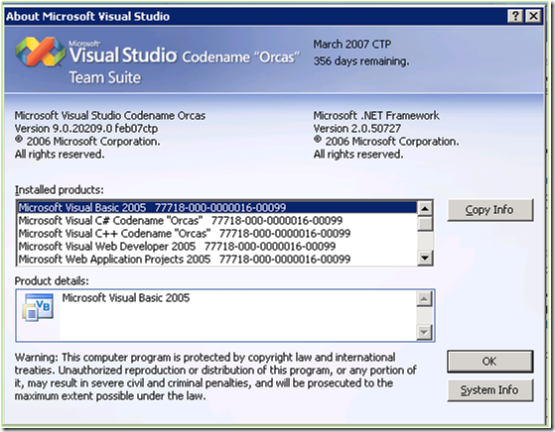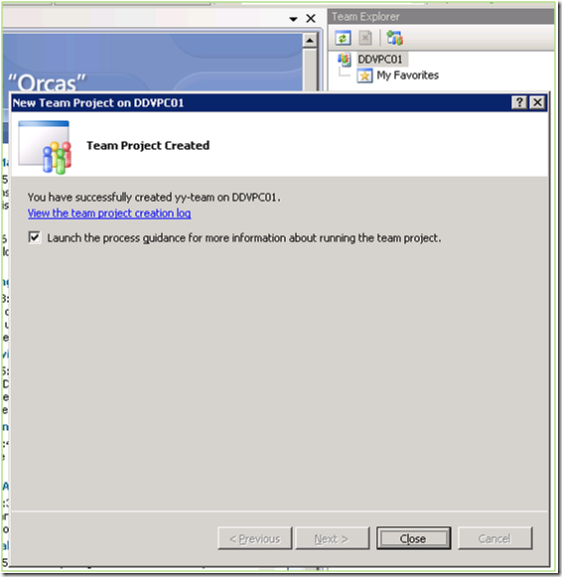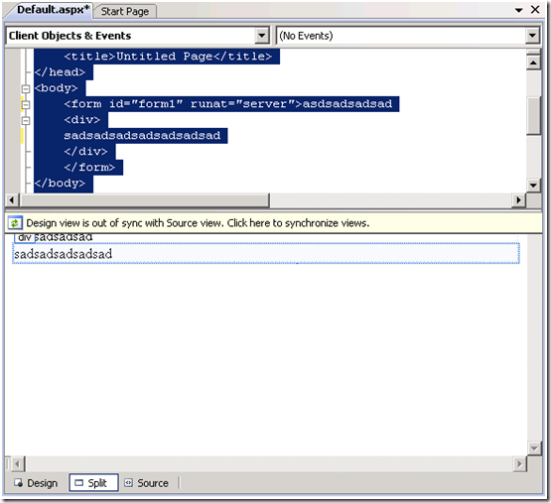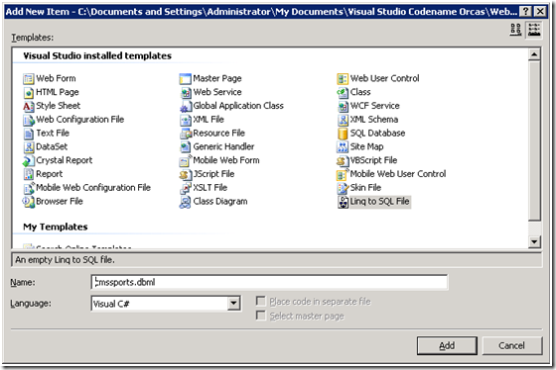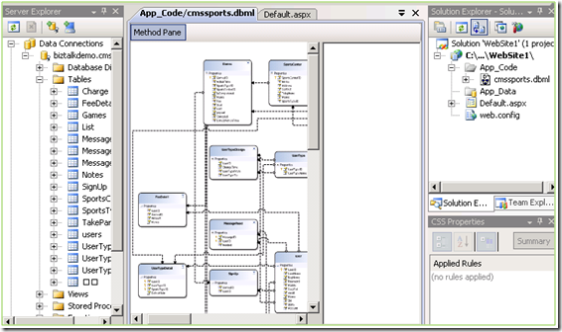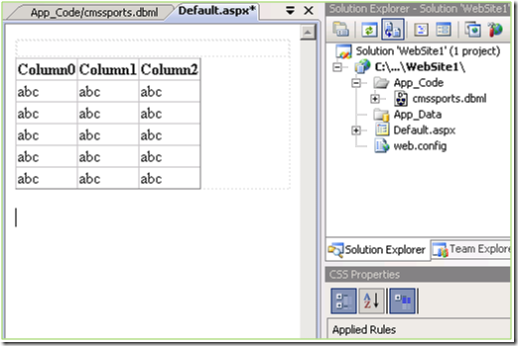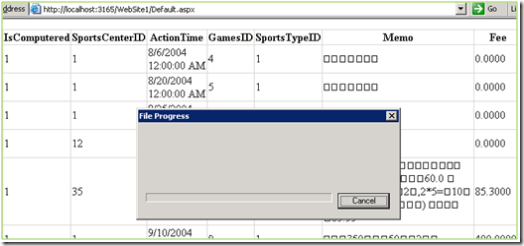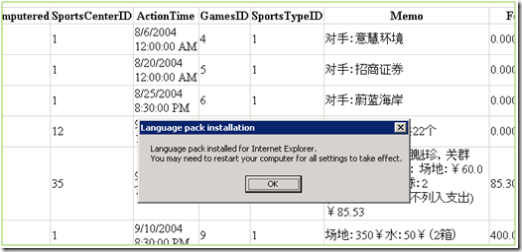| 英文介绍: |
| Overview |
| Visual Studio code name "Orcas" delivers on Microsoft's vision of smart client applications by enabling developers to rapidly create connected applications that deliver the highest quality rich user experiences. This new version enables any size organization to rapidly create more secure, manageable, and more reliable applications that take advantage of Windows Vista and the 2007 Office System. By building these new types of applications, organizations will find it easier than ever before to capture and analyze information so that they can make effective business decisions.
This download is the March 2007 Community Technology Preview of Microsoft Visual Studio Code-Named "Orcas". This CTP is available in English only.
Note: |
- This CTP is available as a Virtual PC image or as a self-extracting image. If you wish to use the Virtual PC image you will need Virtual PC or Virtual Server to run this image. If you wish to use the self extracting install, we advise that you do not install this on a production machine. Depending on your hardware the download files make take between 30-60 minutes to decompress.
|
- For the Orcas March CTP release, please ensure that you have followed the instruction described below.
|
- Download both the Orcas Base Image (if you haven't done this for the previous CTPs) and all eight files of the differencing image to your local machine
|
- Launch the differencing image on your Virtual PC or Virtual Server and logon using the credential below:
|
| |
| |
| |
| This CTP targets early adopters of the Microsoft technology, platform, and tools offerings. It enables developers to experience the upcoming toolset and underlying platform improvements. We designed this release to enable developers to try out new technology and product changes, but not to build production systems. This limitation is fully covered in the EULA that accompanies this CTP.
The highlights of this CTP include: |
- LINQ
The LINQ Project: this CTP represents a major milestone in the LINQ project. For more information about LINQ click here. |
- VB 9.0 Language Support: This CTP contains the following language features:
|
- Query Expressions: Basic querying, filtering, and ordering support
|
| |
| |
- Local Variable Type Inference
|
| |
| |
| |
- New Line and Expression IntelliSense
|
- C# 3.0 Language Support: This CTP implements all of the C#3.0 language features from the May LINQ CTP including:
|
| |
- Object and Collection Initializers
|
| |
- Local Variable Type Inference and Anonymous Types
|
- Lambdas bound to Delegates and Expression trees
|
- Complete design-time support: Intellisense, Formatting, Colorization
|
| |
- ADO.NET is fully integrated with LINQ and offers many options for using LINQ in various scenarios: LINQ to SQL provides direct access to database tables from the programming environment, LINQ to Entities enables developers to use LINQ over EDM models, and LINQ to DataSet allows the full expressivity of LINQ to be used over DataSets.
|
- LINQ to Entities enables developers to program against a relational database using a view of the data that is appropriate for the application they are building, independent of the structure of the underlying database. The use of the Entity Data Model (EDM) enables developers to design models that follow the concepts built into the application, instead of having to map them to constructs available in relational stores. LINQ to Entities is built on the ADO.NET Provider model and will support working against different back end relational stores in addition to Microsoft SQL Server. This CTP includes a LINQ to Entities provider for SQL Server and SQL Server Compact Edition.
|
- LINQ to SQL (previous name DLinq) has enhanced the functionality from the May 2006 LINQ CTP. You can find it in System.Data.Linq namespace in System.Data.Linq.dll. New in this release is that DataContext provides optimized modes for read-only use and serialization . Also new is that DataShape streamlines eager loading capabilities and adds the ability to set queries on relationships
|
| |
- Methods can be created from stored procedures and functions within the designer.
|
- Better handling of database schemas.
|
- Improved inheritance support in the designer.
|
| |
- System.Xml Bridge Classes added – There is a set of extension methods allowing XPath / XSLT to be used over LINQ to XML trees, allow XSLT transformations to produce an LINQ to XML tree, and to validate an XElement tree against an XML Schema.
|
- Event Model - This allows LINQ to XML trees to be efficiently synchronized with a GUI, e.g. a Windows Presentation Foundation application
|
- Class hierarchy changes - XObject class added, XStreamingElement class (temporarily) removed
|
- Various understandability / usability improvements – There have been a number of relatively minor changes done in response to internal reviews, usability studies, and external feedback to make the API more clean and consistent.
|
| |
- The LINQ to Objects API supports queries over any .NET collection, such as arrays and Generic Lists. This API is defined in the System.Linq namespaces inside System.Core.dll.
|
| |
- Extended, more powerful data APIs with the ADO.NET Entity Framework
|
- With the ADO.NET Entity Framework developers will be able to model the view of the data that is appropriate for each one of the applications they are building, independently of the structure of the data in the underlying database. The use of the Entity Data Model (EDM) enables developers to design models that follow the concepts built into the application, instead of having to map them to constructs available in relational stores. Once the model is in place, the powerful ADO.NET Entity Framework API is used to access and manipulate the data as .NET classes or as rows and columns, whatever is appropriate for each application.
|
- Added paging and stored procedures for update ("update customization") for ADO.NET Entity Framework:
|
- Paging: the paging support in the ADO.NET Entity Framework allows developers to "page" over data in a database by indicating the start row and number of rows to be included in the result. Paging is available through Entity SQL (using the LIMIT AND SKIP keywords) and through the query-builder methods in the ObjectQuery <T> class (Top and Skip). In a future CTP the feature will also be enabled to be used in LINQ queries by means of the standard Take and Skip LINQ operators.
|
- Stored-procedures for update customization: the Entity Framework by default automatically generates SQL statements for insert, update and delete operations when processing changes to entities in memory to be sent to the database. With the stored-procedures update customization feature developers have the option to override the automatic SQL generation and instead provide stored-procedures that will perform the insert, update and delete operations, which the system will call during entity change processing. Among other things, this enables scenarios where direct access to tables is restricted in the database and the only way to make changes to the data is through stored-procedures.
|
- Microsoft Synchronization Services for ADO.NET
|
- Provides an application programming interface (API) to synchronize data between data services and a local store. The Synchronization Services API is modeled after the ADO.NET data access APIs and gives you an intuitive way to synchronize data. It makes building applications for occasionally connected environments a logical extension of building applications where you can depend on a consistent network connection. For details please visit http://go.microsoft.com/fwlink/?LinkId=80742 .
|
| |
- Improvements for web development in this CTP include:
|
- New ASP.NET WebForms design-surface with advanced XHTML and CSS features
|
- JScript intellisense for ASP.NET AJAX and browser DOM
|
- Multi-targetting for .NET Framework 2.0, 3.0, and 3.5 in websites and web applications
|
- LINQ to SQL designer integration in websites and web applications
|
- Client App-Level Services
|
- Enable client application developers to use the same user profile and login services as your Web applications. This enables customers to utilize on set of backend storage for user personalization and authentication regardless of the applications type.
|
| |
- Workflow Rules allows users to enter rules (and conditions) in a code-like manner
|
- Support the use of the new C# Extension methods features in their rules
|
- Enable operator overloading and the new operators in their rules
|
| |
| |
- Enables Input Data Breakpoints allowing the user to break the execution of the style-sheet whenever a certain node in input document is hit.
|
- XML Editor Performance Improvements
|
- Performance in the Xml Editor for Intellisense, schema validation etc is improved by implementing incremental parsing of the XML Document.
|
- Seamless transition between XML Editor and XSD Designer
|
- Improves the experience a user has when working with an XML Schema in textual and graphical mode at the same time.
|
| |
- Parallel/Multi-Processor Builds
|
- Building multiple projects in parallel, as much as possible based on the use of dependency information in projects to parallelize
|
- Allowing the developer/builder to control the parallelism by providing them the ability to specify the number of processors to use for build.
|
- UAC Manifests in the Managed Build Process
|
- Support for manifests that are embedded into the final executable via the Build process.
|
| |
- Windows Presentation Foundation (WPF) Designer ("Cider") & Application Tools to deliver the ability to:
|
- Create, edit, build, run and debug WPF projects
|
| |
- Preview any XAML in the designer including user defined controls and types
|
- Design Windows, Pages and UserControls
|
- Do basic layout tasks in a Grid
|
- Do basic property editing using the new property browser
|
- Easily understand and navigate "document structure" using the Document Outli
|
- See changes in the designer immediately in the XAML
|
| |
- Edit XAML with intellisense
|
- See changes in the XAML immediately in the designer
|
- Build design time for WPF controls
|
- UAC manifests in the IDE for Windows Vista applications
|
- Enable developers on Windows Vista to easily include the UAC manifest as an embedded resource.
|
| |
- Add IRI support (RFC 3987) to URI related classes
|
- This allows resource identifiers to be specified using a character set that supports all languages.
|
- New Async model on Socket class
|
- A new Async model is reduces the per I/O overhead compared to the current I/O model
|
| |
- Delivers a set of peer-to-peer network APIs that allow a developer to easily extend an application with compelling collaboration functionality.
|
- WMI.NET Provider Extension 2.0
|
- WMI.NET Provider Extension 2.0 simplifies and enhances the development of WMI providers in the .Net framework to enable the management of the .NET applications while minimizing the impact on the development time.
|
- Delivers equivalent access to WMI features and functions available to native code providers.
|
- Exposes property updates and methods to managed code.
|
- Improved scalability for large collections of WMI entities.
|
| |
- Enable ClickOnce deployment for Microsoft Office applications
|
- Developers now have an easy to use and version resilient security model for their applications that will exist for future versions of Visual Studio and Office. With full support for ClickOnce deployment of all Office 2007 customizations and applications, developers and administrators now have the right tools and framework for easy deployment and maintenance of their Office solutions.
|
| |
| |
- Top-down system design allows an application architect/lead developer to perform the design of a business solution without having to be confronted with technology decisions. It enables the user to progressively refine a high-level system design, designing new sub-systems and applications in the context of the system in which they are to be used.
|
- Architectural Roles on System, Applications and Endpoints
|
- Enables an architect, while working on the high-level design of a system's architecture using the System Designer, to introduce elements into the design that play a specific pre-defined architectural role(s) within architectural patterns.
|
| |
- Profiler Support for WCF Applications
|
- Enable profiling of WCF based applications to improve application performance
|
- Customize and extend code correctness policies
|
- Code Analysis Check-in Policy improvements to communicate to a developer why the check-in policy failed and to provide guidance on how to pass the policy requirements.
|
- Performance tune an enterprise application
|
- Enables developers to run profiling during load and test procedures for a system, to see how it behaves, and use integrated tools to profile, debug and tune. This also enables performance base-lining, so that users can save a baseline profile and then, if the performance degrades, compare up-to-date traces to identify the source of the regression
|
| |
- Unit Test Generation Improvements
|
- Improvements to unit test generation provide an easy way for the user to specify what methods to test, and generate test methods and helper code to do unit testing, as well as providing unit test support for generics.
|
- Web Test Validation Rule Improvements
|
- Web Test rules improvements enable testers to create more comprehensive validation rules for the application being tested. These improvements include the following functions:
|
| |
- Search request and response
|
- Add validation rule for title
|
| |
- Provide test level validation rules
|
| |
- Warning level for errors on dependents
|
- Better Web Test Data Binding
|
- This feature allows users to data bind .CSV and XML files, as well as databases to a web test, using a simple databinding wizard.
|
- Improved Load Test Results Management
|
- With this feature user can open or remove an existing load test result from the load test repository. User can also import and export load test results files.
|
| |
| |
- Support multi-threaded builds with the new MSBuild.
|
- Continuous Integration – There are many components to this, including build queuing and queue management, drop management (so that users can set policies for when builds should be automatically deleted), and build triggers that allows configuration of exactly how when CI builds should be triggered, for example – every checkin, rolling build (completion of one build starts the next), etc.
|
- Improved ability to specify what source, versions of source, etc to include in a build.
|
- Improved ability to manage multiple build machines.
|
- Simplified ability to specify what tests get run as part of a build
|
| |
- Destroy- The version control destroy operation provides administrators with the ability to remove files and folders from the version control system. The destroyed files and folders cannot be recovered once they are destroyed. Destroy allows administrators to achieve SQL server disk space usage goals without constantly needing to add more disks to the data tier machine. Destroy also facilitates removing versioned file contents that must be permanently removed from the system for any other reason.
|
- Annotate - Annotate is a feature that allows developers to inspect a source code file and see at line-by-line level of detail who last changed each section of code. It brings together changeset data with difference technology to enable developers to quickly learn change history inside a source file.
|
- Folder Diff - Team Foundation Server now supports compare operations on folders, whereby the contents of the folder are recursively compared to identify files that differ. Folder diff can compare local folders to local folders, local folders to server folders, and server folders to server folders. It's a great way of identifying differences between branches, files that you've changed locally, and files that have changed between two points in time.
|
- Get Latest on Checkout - As an optional setting on a team project or on an individual basis, you can have Team Foundation Server always download the latest version of a file when you check it out. This helps ensure that you don't have to merge your changes with somebody else's when you check the file back in.
|
| |
- This release includes numerous improvements in performance and scalability of Team Foundation Server.
|
| |
- Easily add the Windows Vista "Look and Feel" to native C++ applications
|
- Developers can use Visual Studio to build ISV applications that exhibit the Windows Vista "look & feel". A number of the Windows Vista "look & feel" features are available simply by recompiling an MFC application. Deeper integration that requires more coding or design work on the part of the developer is also simplified with Visual Studio's integrated support for the Windows Vista native APIs.
|
- Windows Communication Foundation and Workflow Foundation
|
- WF Designer and Debugger integration with Visual Studio
|
| |
- New WCF Send and Receive Activities
|
- Enhanced Workflow and Service hosting
|
| |
- Added support for operator overloading
|
- Added support for the "new" operator to allow users to new up objects and arrays from WF Rules
|
- Added support for extension methods to make user's experience calling extension methods from WF Rules compatible with how they code in C#
|
- Partial Trust support in WCF when using the BasicHttpBinding
|
- Enhanced REST/POX Support in WCF
|
- RSS and Atom Programming Model
|
- Atlas Integration, end-to-end programming model for building Ajax style web applications using WCF services.
|
- Support for OASIS specifications WS-AtomicTransaction 1.1, WS-Coordination 1.1, WS-ReliableMessaging 1.1, WS-SecureConversation 1.3, and WS-Trust 1.3
|
- New Templates for simplified WCF Service Authoring
|
| Existing CTPs: As Visual Studio code name "Orcas" CTPs are released on a predefined cadence, existing CTPs (such as the LINQ May 2006 CTP) may not yet have been integrated into a given "Orcas" CTP release (This should not be taken as a change in commitment to any existing technology that has been made available as a CTP but instead is just a real world example of how large applications, with many technology areas, are built. We will be integrating this existing functionality into future CTP builds.
Developers using a VPC image can run the CTP on a machine without impacting any existing software installations. The CTP can be removed by deleting the folder and using the Virtual PC application to remove the configuration information.
This image ships with networking set to "local". This setting enables the virtual machine to think it is connected to a network without actually connecting and exposing the machine to the Internet. We recommend that customers do not modify the networking settings. Customers who wish to turn networking "on" to connect the image to a physical network are advised that they will need to ensure the security of the virtual machine as well as apply any security updates that may have become available since the release of this image. |



